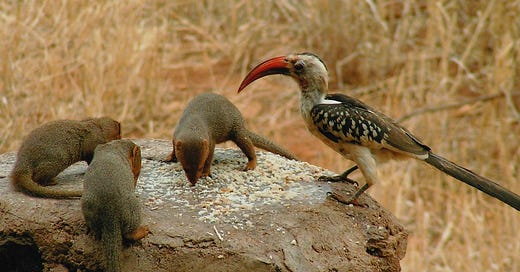The Dwarf Mongoose and the Hornbill
Building innovation ecosystems attracts a lot of good intentions and deliberate design. My experience is that doesn't work so well. Are we brave enough to take a step back?
tl:dr Ecosystem architects are models of best practice and good intentions. That doesn’t align so well with what works in the real world. Fundamentally, designing and directing ecosystems is at odds with the whole concept. We need to be brave enough for government and others to take a big step back. Innovation will flourish in a closer imitation of a natural, evolutionary ecosystem.
The dwarf mongoose and the hornbill. No-one would design collaboration this way and there is nothing else like it. Yet sitting on the back of a bukkie in the African sun, watching them gather to hunt, it seems like the most natural thing in the world. How can we learn from this?
Ecosystem architects?
A good friend of mine, Andrew Barrie, recently posted about ecosystems on the Community Lab which he runs. He listed some ingredients for a successful ecosystem:
I have seen many lists like this. It is full of best practices and good intentions. No-one could argue with any of these virtues. Most likely there is plenty of academic research backing up why each of these qualities is essential for a successful innovation ecosystem.
Innovation in the real world
My observation of successful innovation in the real world is different. Specifically, the most successful innovation ecosystems (Silicon Valley, Boulder, Israel, Estonia) do not fit this definition in at least three areas:
Shared Vision and Purpose: quite the opposite. Innovators pursue their own vision, often in direct conflict with others in the ecosystem.
Aligned Incentives: again the opposite is true. Players in the ecosystem often have conflicting or contrasting incentives. Even when these are presented as aligned - eg entrepreneurs and investors.
Effective Facilitation and Leadership: ecosystems generate their own energy and momentum. Leadership by entrepreneurs helps - Brad Feld's book is especially strong on this - but this is a distributed, networked effect not a driver.
Nature does not design ecosystems
Here is the fundamental point. The ecosystem concept is drawn from nature. Ecosystems in nature are not designed or directed. They evolve naturally with very different elements that draw strength from different roles within the whole system.
The incentives and purpose of lions, antelope, dung beetles and acacia thorn could not be more different. Yet they all thrive together in the same ecosystems.
Natural ecosystems fail when the balance of these is disturbed in some way. At the same time, that balance is dynamic and evolving constantly. So the item from the above list that jumps out as most important is adaptability and learning.
Why government should step back
At the risk of stretching my own metaphor, the role of government in innovation is a little like the role humans play in the African savannah. Man is the apex predator. But the rest of the ecosystem can only thrive if we stand back from that role and allow all the other elements to thrive.
In my thinking about innovation the role of government should be distant at best. Not least because government tends to favour setting direction and purpose in ways which create friction and misdirect innovation. The world is full of well intentioned policies and initiatives that follow the model you have described but deliver little. The recent Sinker report on health innovation and the UK Government 50 Point Plan for AI are recent illustrations.
I think this stuff really matters. We see a growing gap in productivity and prosperity between the US and Europe, including the UK. Lower levels of innovation, especially in technology, are one of the key elements in that gap. It seems obvious to me that more government is not the solution.
Benefits of a natural ecosystem
This is not just me being a grumpy old man. These virtuous misconceptions have a serious cost. To see why, think about the benefits of a successful, thriving ecosystem in nature:
Evolution becomes a process of innovation. Each species finds its way by trial and error. Only those that succeed survive.
And each survives in its own niche. Thriving ecosystems are all about specialisation. Specialisation to fit the conditions and constraints and within the hierarchy and the food chain.
That means high levels of variation. Ecosystems succeed because of the differences between species, not because they are aligned to any common purpose.
It also creates maximisation. A wide variety of unique ways to survive and thrive makes the most complete and abundant use of the resources available within an ecosystem.
Ecosystems are sustainable. Developing and thriving through climate variations, species evolution and natural disasters alike.
Are we brave enough?
On reflection, Architects is not the right word. In many ways, our innovation ecosystem will flourish entirely on its own. We live in a rich, free country with the rule of law and a trusted business environment.
In the end, it comes down to the dwarf mongoose and the hornbill. There is a role for some seeding, nurturing and encouragement. If we want to realise our potential, we need to be brave enough to leave it at this.
Thanks for reading.





